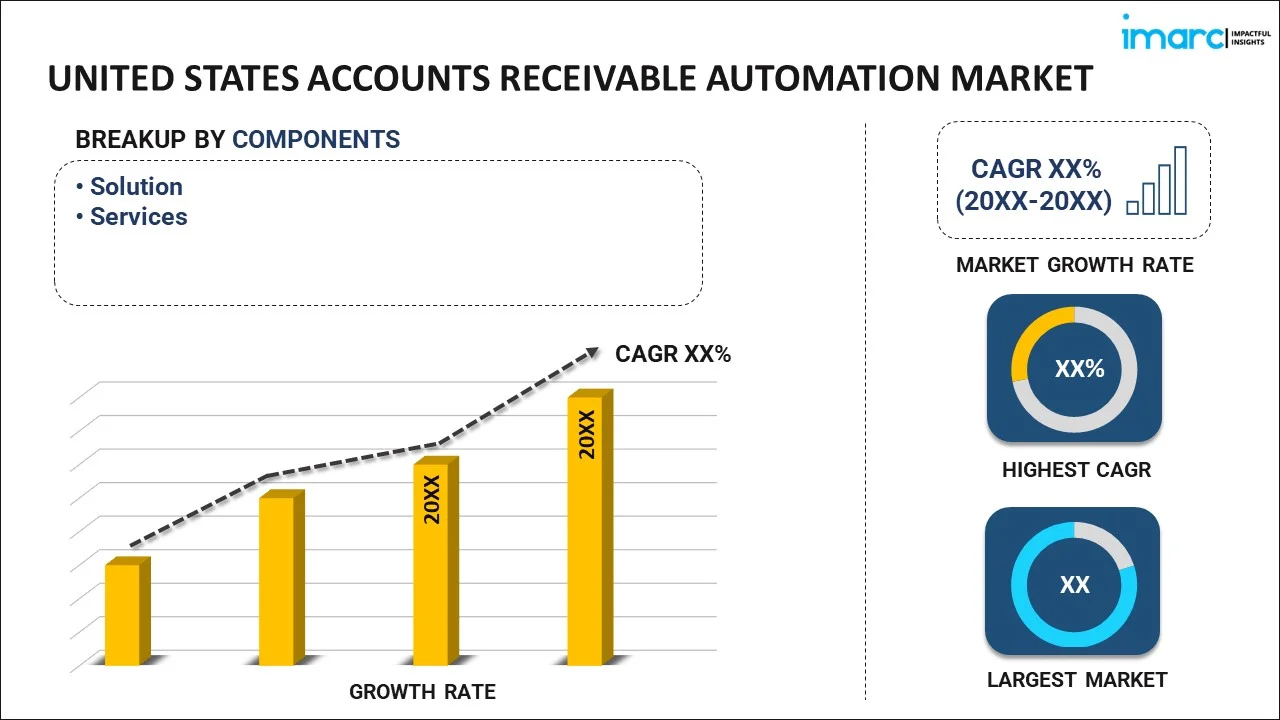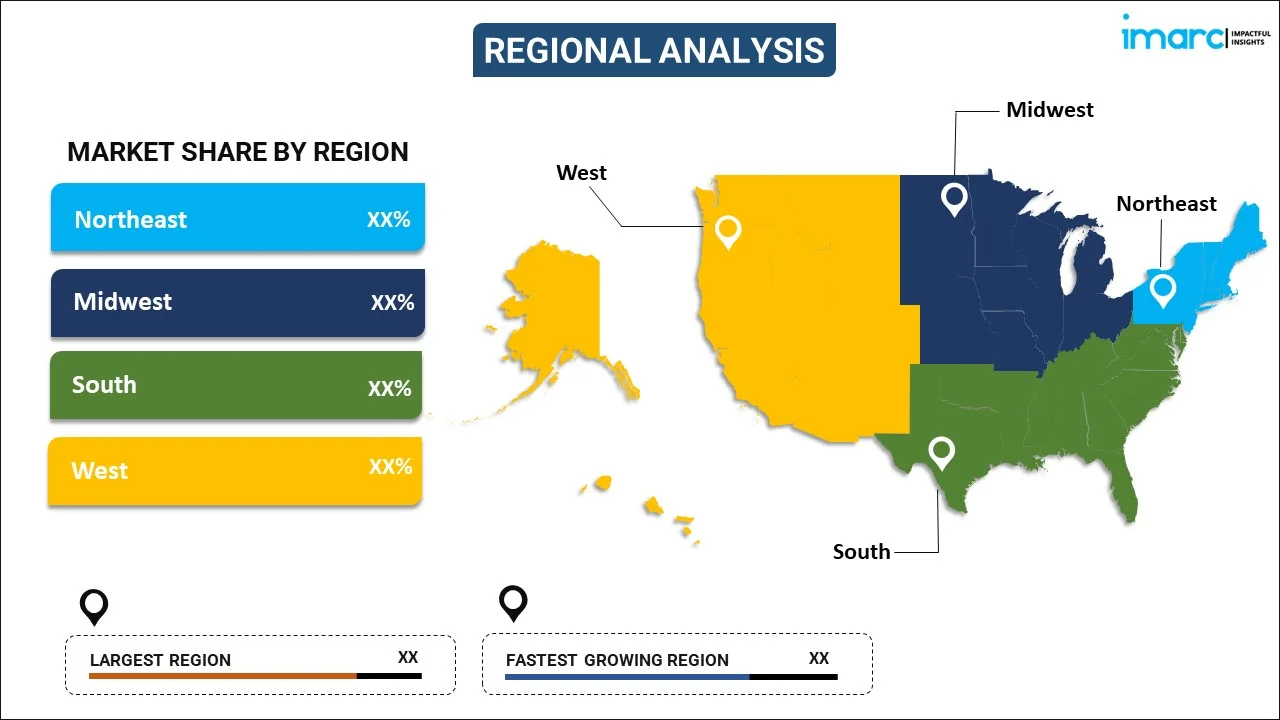
United States Accounts Receivable Automation Market Report by Component (Solution, Services), Deployment (On-premises, Cloud-based), Organization Size (Large Enterprises, Small and Medium-sized Enterprises), Vertical (Consumer Goods and Retail, BFSI, Manufacturing, IT and Telecom, Healthcare, Energy and Utilities, and Others), and Region 2026-2034
Market Overview:
United States accounts receivable automation market size reached USD 760.7 Million in 2025. Looking forward, IMARC Group expects the market to reach USD 1,731.0 Million by 2034, exhibiting a growth rate (CAGR) of 9.57%% during 2026-2034. A paradigm shifts in financial management practices, along with the widespread adoption of enhanced software solutions to automate tasks, is primarily driving the United States accounts receivable automation market share.
|
Report Attribute
|
Key Statistics
|
|---|---|
|
Base Year
|
2025
|
|
Forecast Years
|
2026-2034
|
|
Historical Years
|
2020-2025
|
|
Market Size in 2025
|
USD 760.7 Million |
|
Market Forecast in 2034
|
USD 1,731.0 Million |
| Market Growth Rate 2026-2034 | 9.57%% |
United States Accounts Receivable Automation Market Analysis:
- Key Market Trends: Some of the key trends are the fast-paced acceptance of artificial intelligence (AI)-based analytics, cloud platforms, and ERP integration. Firms focus on real-time tracking of invoices, predictive collection, and mobile-friendly solutions. Increased digital transformation efforts and the need for contactless transactions following the pandemic are driving the market toward modernization and innovation at a faster pace.
- Major Growth Drivers: Primary drivers are to enhance cash flow visibility, minimize days sales outstanding (DSO), and optimize customer experience. Increasing volumes of transactions, pressure on labor costs, and the move towards digital-first financial processes also spur demand. Regulatory requirements, security, and increased focus on operating efficiency also drive the expansion of the market across the nation.
- Market Opportunities: Growth opportunities exist in enabling wider adoption of automation by small to mid-sized businesses through scalable, subscription-based models. AI-based credit risk analysis, payment transparency through blockchain, and predictive analytics for decision-making are the most important growth drivers. Customization at the industry level, easy API integration, and global receivables management for multinational companies are other high-growth opportunities for providers.
- Market Challenges: The challenges are high initial implementation expenses, complexities in integration with existing ERP systems, and change resistance from finance teams. Security risks for data, lock-in dangers from vendors, and compliance issues with changing financial regulations pose further obstacles. In addition, varying digital maturity levels between industries hinder uniform adoption, slowing widespread automation implementation in the U.S.
Accounts receivable (AR) automation involves the utilization of technology and software solutions to streamline and enhance the management and collection of payments from customers. The process encompasses the automation of various tasks and workflows associated with accounts receivable, including the creation and dispatch of invoices, monitoring payments, overseeing customer accounts, and addressing overdue payments. Integration with existing accounting and customer relationship management (CRM) systems is a key feature of AR automation. These tools leverage advanced technologies like artificial intelligence (AI), machine learning (ML), and robotic process automation (RPA) to boost efficiency and accuracy in handling accounts receivable processes. The implementation of AR automation contributes to heightened efficiency, a reduction in manual errors, the facilitation of payment processing, improved management of cash flow, timely and precise communication leading to enhanced customer satisfaction, and a clearer insight into the performance of accounts receivable.
United States Accounts Receivable Automation Market Trends:
Improving Cash Flow and Reducing DSO
Effective management of cash flow is essential for organizations, as delays in receivables can peg working capital and affect business operations. Automation of accounts receivable allows for real-time monitoring of invoices, automated payment reminders, and accelerated reconciliation, lowering days sales outstanding (DSO). Organizations are able to immediately identify overdue accounts and prioritize collections strategically to ensure consistent cash flows. Automation also eliminates human errors in billing, which usually result in delayed payments. By speeding up collections, companies improve liquidity, fund growth plans, and minimize use of external financing. The accuracy of anticipating cash flow also aids in strategic financial planning. Since organizations increasingly struggle to maximize cash conversion cycles, automating accounts receivable (AR) processes is a key driver for operational effectiveness as well as financial solidity.
Cost Reduction and Operational Efficiency
Manual accounts receivable functions are labor intensive, require paperwork, and entail repetitive administrative tasks. Automation of these processes lessens dependency on people, decreasing operational costs but enhancing accuracy. AR automation ensures mundane tasks like invoice creation, reminders, payment processing, and reconciliation are simplified, allowing finance teams to concentrate on strategic work. Integration with the ERP and financial systems increases efficiency through centralization of data and elimination of duplications. Automation further lessens errors, delayed payments, and compliance risks that are costly. With financial pressures on companies mounting in terms of staff shortages and increased operational costs, embracing AR automation is a key strategy. By saving costs and enhancing process velocity, companies enjoy increased productivity and increased return on investment.
Digital Transformation and Technology Adoption
The United States market is undergoing swift digitalization, with companies looking for sophisticated solutions for managing finances is a prominent United States accounts receivable automation market trend. Cloud-based systems, AI-based analytics, and machine learning are facilitating predictive collections, real-time reporting, and better decision-making. Automation provides seamless integration with ERP, CRM, and payment solutions, promoting a single, technology-centered financial environment. Firms are also placing emphasis on mobile-enabled solutions, contactless transactions, and self-service channels to enhance customer experiences. The digital finance shift is necessitated by the demand for agility, scalability, and data-driven insights, especially in a competitive business-to-business (B2B) ecosystem. Augmented reality (AR) tool adoption allows organizations to update outdated processes, eliminate errors, and rapidly react to market shifts. In general, technology-based efficiency and innovation are key drivers behind United States accounts receivable automation market growth.
United States Accounts Receivable Automation Market Segmentation:
IMARC Group provides an analysis of the key trends in each segment of the market, along with forecasts at the country level for 2026-2034. Our report has categorized the market based on component, deployment, organization size, and vertical.
Component Insights:

To get more information on this market, Request Sample
- Solution
- Services
The report has provided a detailed breakup and analysis of the market based on the component. This includes solution and services.
Deployment Insights:
- On-premises
- Cloud-based
A detailed breakup and analysis of the market based on deployment have also been provided in the report. This includes on-premises and cloud-based.
Organization Size Insights:
- Large Enterprises
- Small and Medium-sized Enterprises
The report has provided a detailed breakup and analysis of the market based on the organization size. This includes large enterprises and small and medium-sized enterprises.
Vertical Insights:
- Consumer Goods and Retail
- BFSI
- Manufacturing
- IT and Telecom
- Healthcare
- Energy and Utilities
- Others
A detailed breakup and analysis of the market based on vertical have also been provided in the report. This includes consumer goods and retail, BFSI, manufacturing, IT and telecom, healthcare, energy and utilities, and others.
Regional Insights:

- Northeast
- Midwest
- South
- West
The report has also provided a comprehensive analysis of all the major regional markets, which include the Northeast, Midwest, South, and West.
Competitive Landscape:
The market research report has also provided a comprehensive analysis of the competitive landscape in the market. Competitive analysis such as market structure, key player positioning, top winning strategies, competitive dashboard, and company evaluation quadrant has been covered in the report. Also, detailed profiles of all major companies have been provided.
Latest News and Developments:
- In July 2024, U.S. Bank, in partnership with Billtrust, launched Advanced Receivables, an automated end-to-end accounts receivable platform to streamline B2B payment processes. The solution aims to cut costs, reduce manual errors, and accelerate cash flow while enhancing visibility for suppliers. Addressing CFOs’ top priority of cost reduction, the platform integrates U.S. Bank’s payment and risk expertise with Billtrust’s AR technology, aligning with growing corporate investments in financial automation.
- In July 2024, KeyBank, in partnership with Versapay, introduced KeyTotal AR, an AI-driven accounts receivable automation solution for middle-market clients. Designed to streamline collections and automate invoicing, the platform integrates seamlessly with existing ERP systems, enabling faster onboarding without workflow disruptions. With this launch, KeyBank aims to enhance efficiency, reduce payment delays, and provide commercial clients with advanced tools to improve cash flow visibility and receivables management.
United States Accounts Receivable Automation Market Report Coverage:
| Report Features | Details |
|---|---|
| Base Year of the Analysis | 2025 |
| Historical Period | 2020-2025 |
| Forecast Period | 2026-2034 |
| Units | Million USD |
| Scope of the Report | Exploration of Historical and Forecast Trends, Industry Catalysts and Challenges, Segment-Wise Historical and Predictive Market Assessment:
|
| Components Covered | Solution, Services |
| Deployments Covered | On-premises, Cloud-based |
| Organization Sizes Covered | Large Enterprises, Small and Medium-sized Enterprises |
| Verticals Covered | Consumer Goods and Retail, BFSI, Manufacturing, IT and Telecom, Healthcare, Energy and Utilities, Others |
| Regions Covered | Northeast, Midwest, South, West |
| Customization Scope | 10% Free Customization |
| Post-Sale Analyst Support | 10-12 Weeks |
| Delivery Format | PDF and Excel through Email (We can also provide the editable version of the report in PPT/Word format on special request) |
Key Benefits for Stakeholders:
- IMARC’s industry report offers a comprehensive quantitative analysis of various market segments, historical and current market trends, market forecasts, and dynamics of the United States accounts receivable automation market from 2020-2034.
- The research report provides the latest information on the market drivers, challenges, and opportunities in the United States accounts receivable automation market.
- Porter's five forces analysis assist stakeholders in assessing the impact of new entrants, competitive rivalry, supplier power, buyer power, and the threat of substitution. It helps stakeholders to analyze the level of competition within the United States accounts receivable automation industry and its attractiveness.
- A competitive landscape allows stakeholders to understand their competitive environment and provides an insight into the current positions of key players in the market.
Key Questions Answered in This Report
The accounts receivable automation market in the United States was valued at USD 760.7 Million in 2025.
The United States accounts receivable automation market is projected to exhibit a CAGR of 9.57% during 2026-2034, reaching a value of USD 1,731.0 Million by 2034.
Key factors driving the U.S. accounts receivable automation market include the need to improve cash flow, reduce days sales outstanding (DSO), and minimize manual errors. Growing digital transformation, cost reduction pressures, demand for real-time financial visibility, regulatory compliance, and enhanced customer experiences are accelerating adoption across businesses of all sizes.
Need more help?
- Speak to our experienced analysts for insights on the current market scenarios.
- Include additional segments and countries to customize the report as per your requirement.
- Gain an unparalleled competitive advantage in your domain by understanding how to utilize the report and positively impacting your operations and revenue.
- For further assistance, please connect with our analysts.
 Request Customization
Request Customization
 Speak to an Analyst
Speak to an Analyst
 Request Brochure
Request Brochure
 Inquire Before Buying
Inquire Before Buying




.webp)




.webp)












